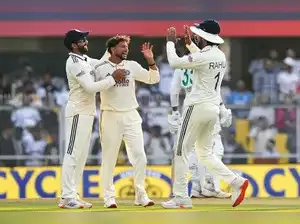If the first day’s play was anything to go by, the Barsapara Cricket Stadium in Guwahati was right at home in Test cricket. A quality Test surface on a mild winter’s day made for an engaging day’s play. Batsmen had every opportunity to absorb pressure and score runs, bowlers were in with a chance, and a decent crowd enjoyed a day out.
At 247 for 6, after choosing to bat, South Africa will concede that India had their noses ahead in the game. Rishab Pant was minted as the 38th Test captain of India, but that did not change their luck at the toss, and this gave Temba Bavuma’s team an ideal chance to get ahead in the game early on.
With a decent covering of grass on the surface, the pitch played true. An early start in the east meant that there was some moisture in the surface. Jasprit Bumrah and Mohammad Siraj, backed up by Nitish Kumar Reddy, quickly summed up the need of the hour. India’s quicks kept it tight, and in response, Aiden Markram and Ryan Rickelton realised they needed to respect the occasion and play the waiting game. Markram was lucky when Bumrah drew his outside edge, only for KL Rahul to drop the chance at second slip.
That blip aside, Markram and Rickelton did the job they were handed. They had played out almost the entire first session, with 82 on the board when Bumrah breached Markram’s defences, giving India their first breakthrough.
Rickelton followed with no addition to the score, edging a tossed-up Kuldeep Yadav delivery for Pant to pouch.
This would more or less be the template for the day. South Africa’s batsmen would get in, stitch together a partnership, picking off the loose deliveries, keeping the scoreboard ticking over, only for India to find a way back into the game.
This was possible because India had a high-quality bowling attack that could ask questions even on a true first-day surface. Bumrah exerted a high degree of control, holding a line and hitting a length too short to drive, using the fuller ball with purpose. Siraj was his tireless self and, aside from a couple of attempted inswingers gone wrong, bowled to his fields. Washington Sundar and Ravindra Jadeja stuck to their plans, not attempting anything out of the ordinary.
But Kuldeep was the factor that pulled the game India’s way. You don’t expect a spinner to be the most attacking option on the first day of a Test, but Kuldeep constantly challenged both edges. He bowled at a good pace through the air, and when the ball was tossed up, it had enough action on it to ensure it dipped and did not just float through.
Kuldeep received constant input from his wicketkeeper-captain, and the chemistry of this partnership was obvious. At times, Kuldeep took the lead and probed in the manner he thought most likely to get a wicket. At others, very specific fields were set for certain batsmen, and Kuldeep followed through, allowing the wicket to come. With 3 for 48, Kuldeep was the pick of the bowlers.
“I thought it’s a massive contrast from the Kolkata pitch, for one thing. We were expecting a better wicket. I thought it was pretty lifeless, but I’ve just heard Tristan Stubbs say that it was quite hard to score as well,” said Ryan ten Doeschate, India’s assistant coach, at the end of the day’s play. “I think it was just good old-fashioned attritional Test cricket.
“The way we assessed the wicket, we thought it might do a little bit this morning. Obviously, if you play two seamers, you have to go to spin very early, and it’s difficult for the captain to juggle just two seamers. Obviously, if you go for an out-and-out seamer, you’re one batter less,” he said.
“So on balance, we thought it was the best strategy to play the bowling allrounder [Nitish], someone who we feel can get big runs as well. As it turned out, we didn’t feel that you needed any more seam than just the two today, but we still feel it’s the right balance with four days to go in the Test.”
Doeschate also made the point that first-innings runs would be crucial on this surface, on top of the first hour being crucial. And so, familiarity returned to Test cricket once the pitch played true. How it will change and at what pace will determine how this game unfolds, but one thing seems already apparent: the team with the greater appetite for hard work will come out on top.
Brief Scores: South Africa 247/6 (Stubbs 49, Bavuma 41, Markram 38, Rickelton 35; Kuldeep 3/48) vs India at stumps on Day 1.
At 247 for 6, after choosing to bat, South Africa will concede that India had their noses ahead in the game. Rishab Pant was minted as the 38th Test captain of India, but that did not change their luck at the toss, and this gave Temba Bavuma’s team an ideal chance to get ahead in the game early on.
With a decent covering of grass on the surface, the pitch played true. An early start in the east meant that there was some moisture in the surface. Jasprit Bumrah and Mohammad Siraj, backed up by Nitish Kumar Reddy, quickly summed up the need of the hour. India’s quicks kept it tight, and in response, Aiden Markram and Ryan Rickelton realised they needed to respect the occasion and play the waiting game. Markram was lucky when Bumrah drew his outside edge, only for KL Rahul to drop the chance at second slip.
That blip aside, Markram and Rickelton did the job they were handed. They had played out almost the entire first session, with 82 on the board when Bumrah breached Markram’s defences, giving India their first breakthrough.
Rickelton followed with no addition to the score, edging a tossed-up Kuldeep Yadav delivery for Pant to pouch.
This would more or less be the template for the day. South Africa’s batsmen would get in, stitch together a partnership, picking off the loose deliveries, keeping the scoreboard ticking over, only for India to find a way back into the game.
This was possible because India had a high-quality bowling attack that could ask questions even on a true first-day surface. Bumrah exerted a high degree of control, holding a line and hitting a length too short to drive, using the fuller ball with purpose. Siraj was his tireless self and, aside from a couple of attempted inswingers gone wrong, bowled to his fields. Washington Sundar and Ravindra Jadeja stuck to their plans, not attempting anything out of the ordinary.
But Kuldeep was the factor that pulled the game India’s way. You don’t expect a spinner to be the most attacking option on the first day of a Test, but Kuldeep constantly challenged both edges. He bowled at a good pace through the air, and when the ball was tossed up, it had enough action on it to ensure it dipped and did not just float through.
Kuldeep received constant input from his wicketkeeper-captain, and the chemistry of this partnership was obvious. At times, Kuldeep took the lead and probed in the manner he thought most likely to get a wicket. At others, very specific fields were set for certain batsmen, and Kuldeep followed through, allowing the wicket to come. With 3 for 48, Kuldeep was the pick of the bowlers.
“I thought it’s a massive contrast from the Kolkata pitch, for one thing. We were expecting a better wicket. I thought it was pretty lifeless, but I’ve just heard Tristan Stubbs say that it was quite hard to score as well,” said Ryan ten Doeschate, India’s assistant coach, at the end of the day’s play. “I think it was just good old-fashioned attritional Test cricket.
“The way we assessed the wicket, we thought it might do a little bit this morning. Obviously, if you play two seamers, you have to go to spin very early, and it’s difficult for the captain to juggle just two seamers. Obviously, if you go for an out-and-out seamer, you’re one batter less,” he said.
“So on balance, we thought it was the best strategy to play the bowling allrounder [Nitish], someone who we feel can get big runs as well. As it turned out, we didn’t feel that you needed any more seam than just the two today, but we still feel it’s the right balance with four days to go in the Test.”
Doeschate also made the point that first-innings runs would be crucial on this surface, on top of the first hour being crucial. And so, familiarity returned to Test cricket once the pitch played true. How it will change and at what pace will determine how this game unfolds, but one thing seems already apparent: the team with the greater appetite for hard work will come out on top.
Brief Scores: South Africa 247/6 (Stubbs 49, Bavuma 41, Markram 38, Rickelton 35; Kuldeep 3/48) vs India at stumps on Day 1.
(Disclaimer: The opinions expressed in this column are that of the writer. The facts and opinions expressed here do not reflect the views of www.economictimes.com.)





